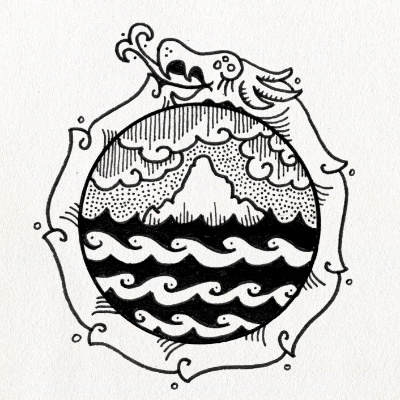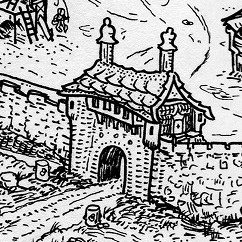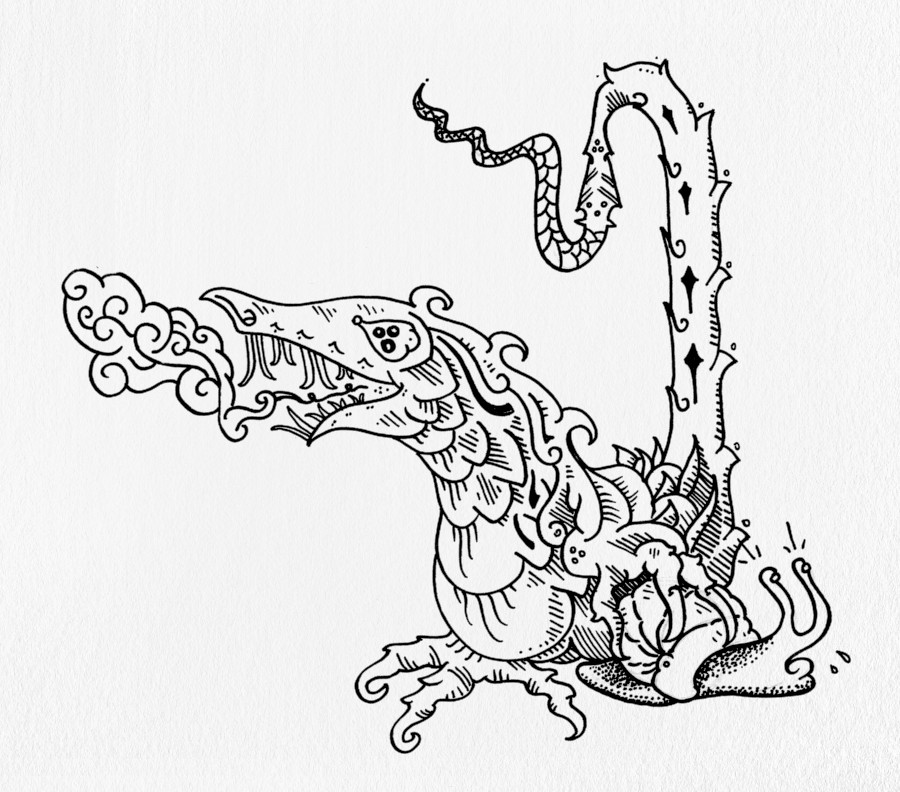
A TRAVEL DIARY BY STIGJAAN AKKLEUS*
A journey begins…
DEEP INTO THE MAINLAND & high up the mountains lies Kartinggaart: a small stronghold that commands the southern approach to the Saksse Highlands. These heights are old and full of history.
The hold is nestled on a small crag from which the source of the river Dool springs forth. We will follow this lazy, agreeable river downstream, to explore Sutbosse*. Hopefully we’ll reach the shore of the ocean one day!
A murmur most fowl
EMBARKING ON THIS TRIP from so far inland will take us along many places with plenty things to see, hear & smell.
But up and down all the riverbanks of Bos one can always expect to spot -or hear- the Common Stýfkwek, the notorious water-fowl with a foul mouth: fugly birds parrot the calls of passing boatsmen, but for some reason they always pick out mild cursewords… So, don’t be too surprised when you’re suddenly being called a Stinkybutt or Poopyface from somewhere out of the reed beds.
And that’s the reason parents won’t let these vulgar avians near their young ‘uns!
Downstream, the past
THE YOUNG BRASH RIVER soon leaves the Saksse Highlands, as we enter the region called Lanqedoor*.
The plains here are dotted with rocky outcrops on which local strongmen of the past built their citadels. Being very fertile though with little large-scale agriculture, Lanqedoor is truly a paradise for various vermin who thrive on the wild rye, malt, grains and berries that grow here so abundantly. In larger settlements the practice of snakehandling was introduced as an official ‘priority profession’ to repel the worst rat infestations.
Tradition afloat
AS THE WATER FLOWS downhill into the vast mainland of Bos, the stream turns rough and wild at times.
Luckily our barge is sturdy enough: a tried and true vessel which is essentially a fortified raft made from pine and rope. This design is known as a Guus, and was first built by mountaineers who floated them along the riverways until they found a new place to settle. The highlanders would then scrap their boats and reuse the timber as building materials.
Once we’ve passed the rapids around Stalvve, we end up on a quieter stretch of the river. A fine moment to sit back and chat with our fellow passengers, most of them travelling merchants on their return from a long trip looking for new wares that might fetch a good price in the coastal cities.
Arrivals, departures
SWEEPING PAST several small villages such as Neevve, Okneevve, and Niweerre, we arrive at Trývant.
This city sits on the border of Vrankke, and its white-chalked walls remind us that Kratat-Imperial* traditions are applied here. And even though this means we have to behave accordingly, there is an upside: the brews are bittersweet, and all food is honey-glazed. A treat for our stomach!
A foxy Dockmaster informs us –stern, but fair– on the Do’s and Don’ts of this place, and points out several times that we should procure new clothing if we are to visit the city centre. Our honest-but-scruffy travellers’ outfits would remind the uppity citizens too much about the uncouth peasants from the surrounding countryside.
New companions!
LEAVING TRYVANT, we pick up some extra passengers. Roeffel Mengpoot is a professional luxury-catscratcher, but he’ll also scratch sheep, oxen, vegetables or your back. For the right price, of course. Also with us is a jester named Poettekatte Sgaevelingk. He’s practicing a trick where you put a coin in a goose’s beak and an egg is supposed to plop out the other side. After spending some coins we’ve still to see our first omelette…
Milk & Honey
WE’VE SPENT the last couple of days roaming the labyrinthine streets and alleys of Brauecdeur.
This is the famed gateway city to Braem, an agricultural region abundant with farmland due to its fabulously fertile soil and friendly weather. The scaly boy is Hibbe Skubsteert, a local Braemer who guided us to all the magnificent sites & sights of the city: its towering causeway, the Council-Theater*, and the ancient Granary building. (And its many many taverns…)

Another week passes just as quick as we float downstream.
Flowing past the small castle of Oellegaart* we gather the borders of Brettalengt & Nyvvelengt are not far off.
Passage, change*
COMING AROUND the Krolleveert Corner we enter the borderlands between Brettalengt & Nyvvelengt. These neighboring -and quarreling- regions are named after the prehistoric queen Bretta and the flying goat-lion Nyvve.
The legends tell that long before there were cities, the breeds of Bos had great trouble building settlements. They would roam across land & sea, harried by beast and punished by weather, seeking shelter under trees and in caves. But resourceful leaders brought permanence to this fraught nomadic existence. By building their own shelter and inviting others to stay by their sise, communities grew and flourished.
Thus the first settlements arose peacefully until one day the manticore Nyvve flew out from a lair in the hills to patrol his lands. Soaring up high he spotted a curious new thing -a house- and he was more than interested: Nyvve dove down, and proceeded to make love to the unfortunate building. Bretta, the lady of said house, would have none of that and promptly cut off the tip of Nyvves tail. The manticore -drama king as he was- bellowed and screamed! He trashed about, wildly flailing his wings and spitting literal vinegar. But when he noticed Bretta had already gone back inside, he retreated back to his hills in shame.
He never gathered the courage to reclaim either his tail ór the land…
The weird abide
WE MANAGED to cross the wetlands that stretch all the way from Vrydeur to Vryvrankke and encountered a swamp trapper. With a unique lure he caught the biggest bugs around. Whether he ate them or fed them to his Snullebird, was unclear. He was no use in ridding us of mosquitos though.
… but it also ends.
NEARING THE END of our first journey we link up with a loud and colorful group of barges whose woodwork is painted in sober maroon and pale sable.
They sport banners the size of sails, and instead of traders or cargo they are loaded with drink, food, and party-goert. It is the circus-fleet of the Duchess Vrydeur, who likes to celebrate any and all holidays on the river.
We’ll accompany this floating carnival all the way back to the city of Vrydeur itself.
The welcoming waves
REACHING THE COAST after so many weeks, we part company with our fellow travellers.
Each will go his or her own way now, back to their daily lives or to new dicoveries.
Yours truly has booked passage on the jolly sailing ship Zwinte-Flixaert: an island-hopper with a most adventurous crew.
While our captain and his crew make their preparations to set sail, we find the shade of a tree to take one last look at the lands of Bos before we take off: towards the speeding skies and nudging waves of Zee*.
Not The End
Notes
Stigjaan Akkleus — Travelling Talesman. Although a scout for exclusive-commodity traders, he always had a keen eye for the world around him. He seems to have disappeared of the map during his latest voyage.
Sutbosse — meaning Southern Bos. A part of the world often visited by the previously mentioned Stigjaan.
See also: Map of Sutbosse
Lanqedoor — the ‘Land of Eternal Rule‘
Stalvestte — Considered part of the settlement Stalvve: a huge trade center for the harvests wild, rare and uncultured foodstuffs (think shrooms, flowers, wild rye and truffels).
Oellegaart — the home of Jan Oelle (not to be confused with (Oellerd Jan)
Kratat-Imperial Regulation — The rules of conduct dictated by the Kratat Dominion, based on the maddeningly complex etiquette of the Kratat nobility. Even short-time visitors and tourists are expected to adhere to a number of fundamental rules in Kratat-aligned cities.
See also: Deyne Kratat
Council-Theater — As in most city-republics the elected representatives have become so numerous they now hold court in the largest venue of the city.
Passage, Change — Bretta & Nyvve are a duo from our clouded past. Their names are remembered in the placenames of Brettalengt and Nyvvelengt.
See also: Bretta & Nyvve
Zee — The wide ocean that surrounds this world. See also: Land & Zee



















